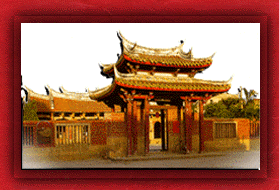


Address/81 Chin-men Alley, Lung-shan-li, Lukang Town, Changhua County
Construction Date/1776
Lung-shan Temple was built during the middle part of the reign of the Ch'ien-lung Emperor, at a time when the city of Lukang had become an important exchange point for trade between the mainland and Taiwan.
It was a time when the town's commercial economy was booming, and its cultural life highly developed. Subsequently, in 1786, thanks to contributions solicited by Ch'en Pang-kuang from the local gentry, the temple was transferred to its present location.
Building materials, including brick, stone and firwood, were specially imported from Fukien, and skilled artisans were employed at great expense from Fukien and Kwangtung to carry out the more specialized aspects of the construction.
Similarly, the architectural design was intended to represent a direct copy of K'ai-yuan Temple in Fukien's Ch'uan-chou(the home district, it should be noted, of many Fukienese immigrants to the island).
The present temple occupies and area of nine thousand six hundred square feet; in the past it had a total of ninety-nine gated(the number nine signifying wholeness), including the Great Gate, the Gate of the Mountain, the Five Gates, the theatre for religious dramas, the Hall of Worship, the Main Hall, the Posterior Hall, the galleries flanking the central courtyard, and the Plafond of the Eight Trigrams behind the theatre.
The temple is adorned with many fine examples of religious art; it represents a fine example of late eighteenth century Ch'uan-chou temple architecture.
Because of its special artistic value in this respect, the temple has become well known among students of classical Chinese architecture.
Though it has been renovated many times, its original design and appearance have, on the whole, been conserved to the present day. The design of the plafond rising above the stage conforms to a pettern often referred to as ' the spider's web ' in Chinese architecture. The basic octangonal design is supported by an interlocking network of elaborately carved and painted brackets arrayed in and around sixteen main buttresses which meet together at the crosspiece (in Chinnese terminology, ' the bright mirror at the center of the rooftop ' ), painted with a tremendously forceful image of the dragon, lord of the elements.
The design of the plafond rising above the stage conforms to a pettern often referred to as ' the spider's web ' in Chinese architecture. The basic octangonal design is supported by an interlocking network of elaborately carved and painted brackets arrayed in and around sixteen main buttresses which meet together at the crosspiece (in Chinnese terminology, ' the bright mirror at the center of the rooftop ' ), painted with a tremendously forceful image of the dragon, lord of the elements.
Schematic drawing revealing the structure of the theatre's design, with important features indicated. 1.Base of stage. 2.Interior supporting column. 3.Exterior supporting column. 4.'Spiderweb' bracket 5.Crosspiece crowning the dome. 6.Lower eave. 7.Middle eave. 8.Upper eave. 9.Subsidiary roof-ridge. 10.Main roof-ridge.
[Pavilion of Taiwan, R.O.C] [Council For Cultural Planning & Development]
[Government & Public Service Pavilion] [Education] [Science & Research]
[Transportation & Communications] [Industry]